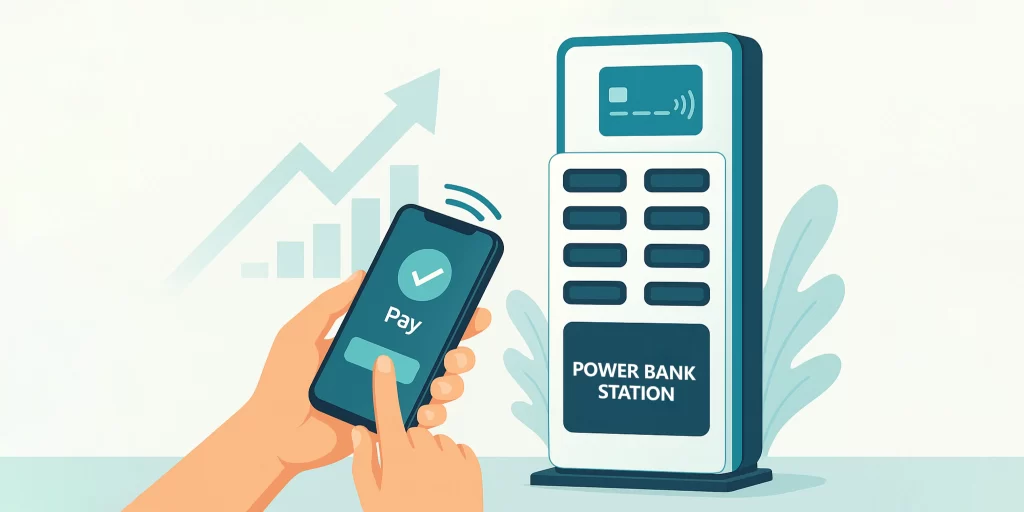
The shared power bank industry is booming, projected to grow from $1.4 billion in 2023 to $16 billion by 2028. As users increasingly rely on these portable charging solutions, seamless mobile payment systems are critical for driving adoption and ensuring user satisfaction. This article explores tailored payment strategies for shared power banks across four distinct market types—mature, fast-growing, transitional, and early-stage—addressing regional nuances and providing data-driven insights to overcome common challenges.
Table of Contents
Mature Markets: Streamlining Established Systems
Mature markets like China and Western Europe boast high smartphone penetration (over 80% in China, per Statista 2024) and robust digital payment infrastructures. In China, with 4.3 million shared power bank stations serving 49 million users in 2023 (iResearch), platforms like WeChat Pay and Alipay dominate, processing transactions in under two seconds.
Strategies.
1. Optimize for Speed: Enhance payment processing to maintain low latency, critical for high-traffic locations like train stations.
2. Integrate with Super-Apps: Leverage platforms like WeChat for in-app rentals, reducing user friction.
3. Data Security: Implement advanced encryption (e.g., AES-256) to protect user data, addressing privacy concerns in GDPR-compliant regions like Europe.
Example
In Shanghai, Monster Charging’s 1.2 million stations (2024) use Alipay’s QR code system, achieving a 98% user retention rate due to seamless payments.
Fast-Growing Markets: Localizing for Scale
Regions like Southeast Asia, particularly Vietnam and Indonesia, are experiencing rapid mobile payment adoption (e.g., Vietnam’s MoMo grew 35% YoY in 2024, per VNExpress). Urban hubs like Hanoi’s Long Bien Bridge see high demand for power banks due to tourism and commuting patterns.
Strategies
4. Localized Payment Options: Support regional wallets like MoMo, ZaloPay, or GoPay to align with user preferences.
5. Multi-Channel Access: Offer QR codes and app-based payments to cater to diverse user habits.
6. Marketing Campaigns: Partner with local influencers to promote payment apps, boosting adoption among younger demographics.
Example
In Jakarta, a 2024 pilot by ChargeNow integrated GoPay, resulting in a 40% increase in rentals within three months, driven by familiarity with the payment platform.
Transitional Markets: Bridging Digital and Cash
Transitional markets, such as parts of Latin America and South Asia, are shifting toward digital payments but still rely on cash (e.g., 60% of transactions in India are cash-based, per RBI 2024). Hybrid payment systems are essential to bridge this gap.
Strategies
7. Hybrid Payment Models: Enable cash top-ups at retail partners or kiosks alongside mobile payments.
8. Simplified Interfaces: Design intuitive apps with multilingual support to accommodate varying digital literacy levels.
9. Incentives: Offer discounts for digital payments to encourage adoption, as seen in India’s UPI campaigns.
Example
In Mumbai, PowerBankIndia’s 2024 rollout of cash-to-digital kiosks at metro stations increased user registrations by 25%, easing the transition to app-based payments.
Early-Stage Markets: Building Trust and Access
Early-stage markets, such as parts of Sub-Saharan Africa, face low digital payment penetration (e.g., only 15% of adults in Nigeria use mobile payments, per World Bank 2024). Infrastructure and trust issues pose significant barriers.
Strategies
10. Partner with Local Retail: Deploy power banks at trusted local shops where users can pay cash or use basic mobile money services like M-Pesa.
11. Offline Payment Options: Use SMS-based payments for users without smartphones, leveraging USSD codes.
12. Community Engagement: Conduct workshops to build trust in digital payments, addressing security concerns.
Example
In Lagos, a 2024 initiative by ChargeAfrica partnered with M-Pesa vendors, achieving a 30% adoption rate among small business owners by offering SMS-based rentals.
Conclusion
Optimizing mobile payments for shared power banks requires a nuanced approach tailored to each market’s stage of development. By leveraging these 12 strategies, businesses can drive adoption and capitalize on the industry’s $16 billion growth potential by 2028. Stakeholders should prioritize user-centric design and strategic partnerships to ensure seamless, inclusive payment experiences worldwide.



